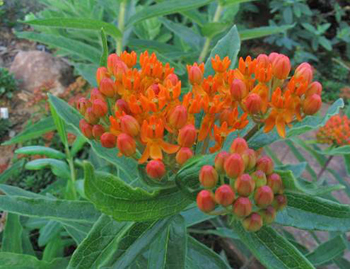Contents:
Common Names | Parts Usually Used | Plant(s) & Culture | Where Found | Medicinal Properties | Biochemical Information
Legends, Myths and Stories | Uses | Formulas or Dosages | Nutrient Content | How Sold | Warning | Bibliography
Scientific Names

- Asclepias tuberosa L.
- Asclepiadaceae
- Milkweed family
Common Names
- Asclepias
- Butterfly weed
- Canada root
- Flux root
- Orange swallow-wort
- Swallow wort
- Tuber root
- White root
- Wind root
Parts Usually Used
The root, dried
Back to Top
Description of Plant(s) and Culture
Pleurisy root is a native North American perennial plant; The fleshy, white, tuber-like, root produces several stout, erect, round, hairy stems (without milky juice) from 1-3 feet high. The alternate, sessile, with watery sap, leaves are lanceolate to oblong, a darker green above than beneath. Bright orange flowers, stamens forming a structure like a crown, grow in terminal, flat-topped, 2-inch, umbels from June to September, later producing long, edible seed pods that are spindle-shaped. Full sun. Zones 3-10. Heat tolerant.
The plant has a nauseous, bitter taste when fresh, but better when dried.
Back to Top
Where Found
Found in dry fields, woods, meadows, prairies, on roadsides, and sandy soils along the east coast and westward to Minnesota, Arizona, and northern Mexico.
Back to Top
Medicinal Properties
Carminative, diaphoretic, diuretic, expectorant, antispasmodic, relaxant, tonic
Back to Top
Biochemical Information
Ascepin is the active principle, asclepiadine, asclepione, cardeno liedes, traces of essential oil, resin, sterol
Back to Top
Legends, Myths and Stories
One species in the Far East was possibly used as a hallucinogen, which is known in the Hindu religion as “Soma”.
As the name suggests, this herb is used for upper respiratory and lung problems.
Back to Top
Uses
Widely used as an expectorant in the late 19th century. It is recommended for colds, flu, scarlet fever, rheumatic fever, bilious fever, typhus, measles, promotes sweating therefore reducing fever, suppressed menses, headache, and bronchial, pleurisy, asthma, and pulmonary problems. Sometimes it was given with cayenne at the beginning of a cold. Native Americans chewed the dried root or made a tea by boiling the root as a remedy for bronchitis, pneumonia, diarrhea, and dysentery. Root poultice used for bruises, swellings, and rheumatism.
Back to Top
Formulas or Dosages
Use the root dried or cooked.
Infusion: steep 1 tsp. of powdered root in 1 cup boiling water for 45 minutes, strain, and take 2 tbsp. every 2 hours; more if necessary.
Decoction: boil 1 tsp. root in 1 cup water. Take 1 to 2 cups per day.
Tincture: take 5 to 40 drops every 3 hours, depending on age and condition. At the beginning of a cold, take 5-15 drops in hot water and 3 grains cayenne every hour until you feel warm throughout. For children, the dose is 1-5 drops.
Back to Top
Warning
Animals have been poisoned by feeding on the leaves and stems. The fresh root may also produce undesirable symptoms. For humans, potentially toxic in large doses. The fresh root can be dangerous. Use only commercial preparations.
Back to Top
Bibliography
![]() The Herb Book
The Herb Book, by John Lust, Bantam Books, 666 Fifth Avenue, New York, NY. copyright 1974.
![]() Back to Eden
Back to Eden, by Jethro Kloss; Back to Eden Publishing Co., Loma Linda, CA 92354, Original copyright 1939, revised edition 1994
 Earl Mindell’s Herb Bible
Earl Mindell’s Herb Bible, by Earl Mindell, R.Ph., Ph.D., Simon & Schuster/Fireside, Rockefeller Center 1230 Avenue of the Americas, New York, New York 10020
![]() Eastern/Central Medicinal Plants
Eastern/Central Medicinal Plants, by Steven Foster and James A. Duke., Houghton Mifflin Company, 215 Park Avenue South, New York, NY 10000
Herbal Gardening, compiled by The Robison York State Herb Garden, Cornell Plantations, Matthaei Botanical Gardens of the University of Michigan, University of California Botanical Garden, Berkeley., Pantheon Books, Knopf Publishing Group, New York, 1994, first edition
![]() Planetary Herbology
Planetary Herbology, by Michael Tierra, C.A., N.D., O.M.D., Lotus Press, PO Box 325, Twin Lakes. WI 53181., Copyright 1988, published 1992
![]() Indian Herbalogy of North America
Indian Herbalogy of North America, by Alma R. Hutchens, Shambala Publications, Inc., Horticultural Hall, 300 Massachusetts Avenue, Boston, Massachusetts 02115, 1973
![]() American Folk Medicine
American Folk Medicine, by Clarence Meyer, Meyerbooks, publisher, PO Box 427, Glenwood, Illinois 60425, 1973
![]() Webster’s New World Dictionary
Webster’s New World Dictionary, Third College Edition, Victoria Neufeldt, Editor in Chief, New World Dictionaries: A Division of Simon & Schuster, Inc., 15 Columbus Circle, New York, NY 10023
 An Instant Guide to Medicinal Plants
An Instant Guide to Medicinal Plants, by Pamela Forey and Ruth Lindsay, Crescent Books (January 27, 1992).
![]() The Yoga of Herbs: An Ayurvedic Guide to Herbal Medicine
The Yoga of Herbs: An Ayurvedic Guide to Herbal Medicine, by Dr. David Frawley & Dr. Vasant Lad, Lotus Press, Twin Lakes, Wisconsin, Second edition, 1988.
 The Rodale Herb Book: How to Use, Grow, and Buy Nature’s Miracle Plants (An Organic gardening and farming book)
The Rodale Herb Book: How to Use, Grow, and Buy Nature’s Miracle Plants (An Organic gardening and farming book), edited by William H. Hylton, Rodale Press, Inc. Emmaus, PA, 18049., 1974
